Intertextuality
November 2, 2009 at 5:33 am Leave a comment
For this assignment I will address the concept of “intertextuality” by taking three digital photographs using as a reference the following list of artists:
Photography 1 (interior) based on an Edward Hopper painting
Photography 2 (interior that refers to exterior) based on Rene Magritte’s work. Manipulation of the photograph must take place.
Photography 3 (exterior) based on the painting addressing the “sublime”. American painting example Thomas Cole.
Digital manipulation is an option in photographs 1 and 3, but is a must in photograph 2.
The content of the photograph as well as the use of people or objects as subjects are open to your creative decisions.
The main idea of intertextuality is based on the principle that the text refers to another text. Context research must be made to understand the text that I’m referring to (paintings in this case). For example: contex–where those paintings were made, the content or subject matter that it depicts, historical and cultural references of the painting, the artist’s position in the history of arts, etc…
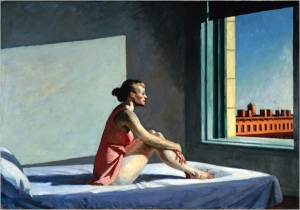 Photography 1 is based on an Edward Hopper painting. I looked on the internet in order to find images that struck me and then tried to learn the story behind these images. Nighthawks is the image I liked the BEST of all of his work. Edward Hopper (July 22, 1882 – May 15, 1967) was a well-known American realist painter and printmaker. He captured urban and rural scenes in detailed renderings, which reflected his personal vision of modern American life. Hopper derived his subject matter from two primary sources: one, the common features of American life (gas stations, motels, restaurants, theaters, railroads, and street scenes) and its inhabitants; and two, seascapes and rural landscapes. Regarding his style, Hopper defined himself as “an amalgam of many races” and not a member of any school. Once he achieved his mature style, his art remained consistent and self-contained, in spite of all the art trends that came and went during his long career. The painting that I’ll be focusing on in this intertextuality assignment is “Morning Sun.” This painting uses a particular pallet of colors. The context is private, Hopper sought to capture, in his words, “the sad desolation” of America. Hopper painted a lonely middle-aged woman (the model was his wife) on a bed in an empty room staring out the window at nothing in particular. By presenting situations that appear unresolved and instilling in them a pervasive sense of solitude, Hooper is able to transform the mundane and familiar into the extraordinary and enigmatic.
Photography 1 is based on an Edward Hopper painting. I looked on the internet in order to find images that struck me and then tried to learn the story behind these images. Nighthawks is the image I liked the BEST of all of his work. Edward Hopper (July 22, 1882 – May 15, 1967) was a well-known American realist painter and printmaker. He captured urban and rural scenes in detailed renderings, which reflected his personal vision of modern American life. Hopper derived his subject matter from two primary sources: one, the common features of American life (gas stations, motels, restaurants, theaters, railroads, and street scenes) and its inhabitants; and two, seascapes and rural landscapes. Regarding his style, Hopper defined himself as “an amalgam of many races” and not a member of any school. Once he achieved his mature style, his art remained consistent and self-contained, in spite of all the art trends that came and went during his long career. The painting that I’ll be focusing on in this intertextuality assignment is “Morning Sun.” This painting uses a particular pallet of colors. The context is private, Hopper sought to capture, in his words, “the sad desolation” of America. Hopper painted a lonely middle-aged woman (the model was his wife) on a bed in an empty room staring out the window at nothing in particular. By presenting situations that appear unresolved and instilling in them a pervasive sense of solitude, Hooper is able to transform the mundane and familiar into the extraordinary and enigmatic.
I will give intertext to the piece by posing as the woman. The only difference is that I will have a sketch board in hand. I will carry the colors through in this piece and may add visual elements to the exterior of the building (the view the woman has of what is happening outside her apartment.
Below is the image that I started out with – we caught the hard light in the morning. As you can see, I DID have the large window to work with as well as the placement of the bed similar to the layout of “Morning Sun.”

For the final intertextual image, I put myself INTO “Morning Sun” by adding the texture and color pallet of this painting. I also was able to simplify the image by taking out miscellaneous items from the photo. I chose to keep the window empty because of Hopper’s style – since you do not know what I am looking at or about to draw, this image is still unresolved and instills in the viewer a sense of imagination.

Taking it a step further, I thought about how Hopper put himself in scenes to capture the moment. I’ve taken moments of time from my own life to show through these window portals, keeping in mind the light source. It’s as though I am reflecting on my future as I am in a sort of seat of control. The intertext is between the current-day life of Lindsey Smith and the current-day lives of those strangers that Hopper would focus on with his paintings. I enjoy the mix of flat and 3-dimensional elements in the below images.
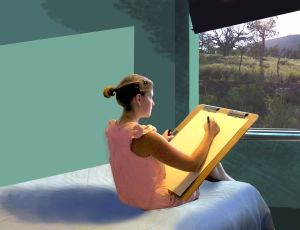
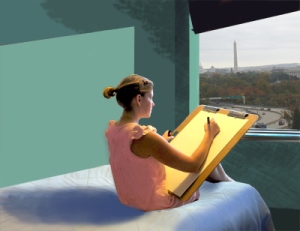
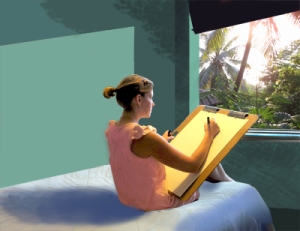
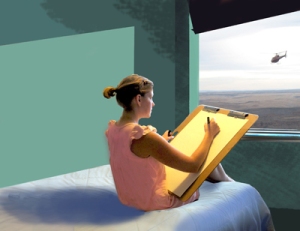
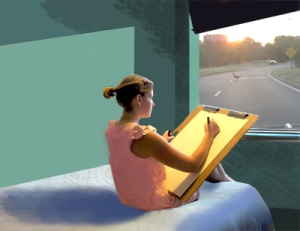
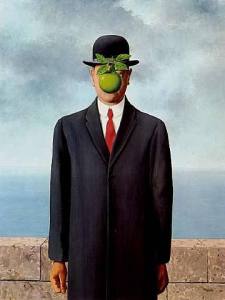
René François Ghislain Magritte (21 November 1898 – 15 August 1967) was a Belgian surrealist artist. He became well known for a number of witty and thought-provoking images. His intended goal for his work was to challenge observers’ preconditioned perceptions of reality and force viewers to become hypersensitive to their surroundings. Magritte’s work frequently displays a juxtaposition of ordinary objects in an unusual context, giving new meanings to familiar things. The representational use of objects as other than what they seem is typified in his paintings. Magritte used this approach in a painting of an apple: he painted the fruit realistically and then used an internal caption or framing device to deny that the item was an apple. In these Ceci n’est pas works, Magritte points out that no matter how closely, through realism-art, we come to depicting an item accurately, we never do catch the item itself. René Magritte described his paintings as “visible images which conceal nothing; they evoke mystery and, indeed, when one sees one of my pictures, one asks oneself this simple question, ‘What does that mean?’. It does not mean anything, because mystery means nothing either, it is unknowable.”
For this intertextual image, I will be using a picture of my husband – Bill Smith in his Marine uniform. Please see this original image, below.

To introduce intertextuality into this image, I will place a apple suspended in air with a bullet zipping through the apple. For the background of this image, I will use a serene setting to juxtapose the images that are being presented.

Photography 3 (exterior) based on the painting addressing the “sublime”. American painting example Thomas Cole. Cole was an English-born American artist. Cole’s Hudson River School, as well as his own work, was known for its realistic and detailed portrayal of American landscape and wilderness, which feature themes of romaticism and naturalism. He did a lot of landscapes. The most famous of these are the five-part series, The Course of Empire, which depict the same landscape over generations—from a near state of nature to consummation of empire, and then decline and desolation.
To create a sublime setting as well as introducing intertextuality, I will create a “paper-doll” technique. Paper dolls are figures made from paper, they have separate clothes that you can hold up to the dolls by folding over tabs. Today, many artists are turning paper dolls into art forms. Instead of covering a human with clothes I will be covering (or dressing) a bare landscape with the sublime beauty of LIFE. Please note all blue area is representing transparency in the cut-outs. The first image is the frame to be used as the back-bone for the images. The frame itself has directions that read:
Entry filed under: Assignments.





Trackback this post | Subscribe to the comments via RSS Feed